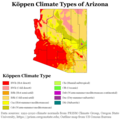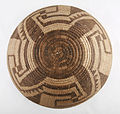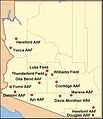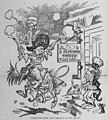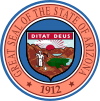Portal:Arizona
| Showcase | Content |
Welcome to the Arizona portal!
Arizona (/ˌærɪˈzoʊnə/ ⓘ ARR-ih-ZOH-nə; Navajo: Hoozdo Hahoodzo [hoː˥z̥to˩ ha˩hoː˩tso˩]; O'odham: Alĭ ṣonak [ˈaɭi̥ ˈʂɔnak]) is a landlocked state in the Southwestern region of the United States. Arizona is part of the Four Corners region with Utah to the north, Colorado to the northeast, and New Mexico to the east; its other neighboring states are Nevada to the northwest, California to the west and the Mexican states of Sonora and Baja California to the south and southwest. It is the 6th-largest and the 14th-most-populous of the 50 states. Its capital and largest city is Phoenix. Arizona is the 48th state and last of the contiguous states to be admitted to the Union, achieving statehood on February 14, 1912. Historically part of the territory of Alta California and Nuevo México in New Spain, it became part of independent Mexico in 1821. After being defeated in the Mexican–American War, Mexico ceded much of this territory to the United States in 1848, where the area became part of the territory of New Mexico. The southernmost portion of the state was acquired in 1853 through the Gadsden Purchase. Southern Arizona is known for its desert climate, with very hot summers and mild winters. Northern Arizona features forests of pine, Douglas fir, and spruce trees; the Colorado Plateau; mountain ranges (such as the San Francisco Mountains); as well as large, deep canyons, with much more moderate summer temperatures and significant winter snowfalls. There are ski resorts in the areas of Flagstaff, Sunrise, and Tucson. In addition to the internationally known Grand Canyon National Park, which is one of the world's seven natural wonders, there are several national forests, national parks, and national monuments. Arizona is home to a diverse population. About one-quarter of the state is made up of Indian reservations that serve as the home of 27 federally recognized Native American tribes, including the Navajo Nation, the largest in the state and the country, with more than 300,000 citizens. Since the 1980s, the proportion of Hispanics has grown significantly owing to migration from Mexico. A substantial portion of the population are followers of the Roman Catholic Church and the Church of Jesus Christ of Latter-day Saints. Arizona's population and economy have grown dramatically since the 1950s because of inward migration, and the state is now a major hub of the Sun Belt. Cities such as Phoenix and Tucson have developed large, sprawling suburban areas. Many large companies, such as PetSmart and Circle K, have headquarters in the state, and Arizona is home to major universities, including the University of Arizona and Arizona State University. The state is known for a history of conservative politicians such as Barry Goldwater and John McCain, though it has become a swing state since the 1990s. (Full article...) Selected article - The geology of the Grand Canyon area includes one of the most complete and studied sequences of rock on Earth. The nearly 40 major sedimentary rock layers exposed in the Grand Canyon and in the Grand Canyon National Park area range in age from about 200 million to nearly 2 billion years old. Most were deposited in warm, shallow seas and near ancient, long-gone sea shores in western North America. Both marine and terrestrial sediments are represented, including lithified sand dunes from an extinct desert. There are at least 14 known unconformities in the geologic record found in the Grand Canyon. Uplift of the region started about 75 million years ago during the Laramide orogeny; a mountain-building event that is largely responsible for creating the Rocky Mountains to the east. In total, the Colorado Plateau was uplifted an estimated 2 miles (3.2 km). The adjacent Basin and Range Province to the west started to form about 18 million years ago as the result of crustal stretching. A drainage system that flowed through what is today the eastern Grand Canyon emptied into the now lower Basin and Range province. The opening of the Gulf of California around 6 million years ago enabled a large river to cut its way northeast from the gulf. The new river captured the older drainage to form the ancestral Colorado River, which in turn started to form the Grand Canyon. (Full article...)Did you know (auto-generated) -
Selected picture -
Havasu Falls, one of the four waterfalls of the Havasupai Indian Reservation, is located near the village of Supai, Arizona. It is the second of four falls on Havasu Creek, which empties into the Grand Canyon on the Colorado River. The water of Havasu Creek has a bluish green tint due to the heavy lime content of the water. The fall is forked and looks like two falls when the river is flowing heavily. More did you know -
WikiProjects
Selected biography -Wayne Douglas Gretzky CC (/ˈɡrɛtski/ GRET-skee; born January 26, 1961) is a Canadian former professional ice hockey player and former head coach. He played 20 seasons in the National Hockey League (NHL) for four teams from 1979 to 1999, retiring at the age of 38. Nicknamed "the Great One", he has been called the greatest ice hockey player ever by many sportswriters, players, The Hockey News, and the NHL itself, based on extensive surveys of hockey writers, ex-players, general managers and coaches. Gretzky is the leading career goal scorer, assist producer and point scorer in NHL history, and has more career assists than any other player has total points. He is the only NHL player to total over 200 points in one season, a feat he accomplished four times. In addition, Gretzky tallied over 100 points in 15 professional seasons, 13 of them consecutive. At the time of his retirement in 1999, he held 61 NHL records: 40 regular season records, 15 playoff records, and 6 All-Star records. Born and raised in Brantford, Ontario, Gretzky honed his skills on a backyard rink and regularly played minor hockey at a level far above his peers. Despite his unimpressive size and strength, Gretzky's intelligence, stamina, and reading of the game were unrivaled. He was adept at dodging checks from opposing players, and consistently anticipated where the puck was going to be and executed the right move at the right time. Gretzky became known for setting up behind his opponent's net, an area that was nicknamed "Gretzky's office". (Full article...)General images -The following are images from various Arizona-related articles on Wikipedia.
News
Wikinews Arizona portal
CategoriesRelated portalsTopicsState facts
State symbols:
Recognized content
Featured articles
Featured lists
Good articles
Featured pictures
Things you can doAssociated WikimediaThe following Wikimedia Foundation sister projects provide more on this subject:
Discover Wikipedia using portals | |||||||||||||||||













